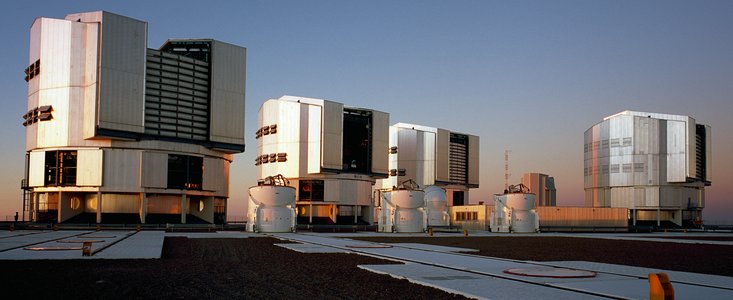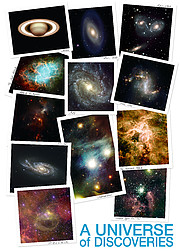Comunicato Stampa
The Perfect Science Machine
ESO celebrates 10 years since First Light of the VLT
27 Maggio 2008
Today marks the 10th anniversary since First Light with ESO's Very Large Telescope (VLT), the most advanced optical telescope in the world. Since then, the VLT has evolved into a unique suite of four 8.2-m Unit Telescopes (UTs) equipped with no fewer than 13 state-of-the-art instruments, and four 1.8-m moveable Auxiliary Telescopes (ATs). The telescopes can work individually, and they can also be linked together in groups of two or three to form a giant 'interferometer' (VLTI), allowing astronomers to see details corresponding to those from a much larger telescope.
"The Very Large Telescope array is a flagship facility for astronomy, a perfect science machine of which Europe can be very proud," says Tim de Zeeuw, ESO's Director General. "We have built the most advanced ground-based optical observatory in the world, thanks to the combination of a long-term adequately-funded instrument and technology development plan with an approach where most of the instruments were built in collaboration with institutions in the member states, with in-kind contributions in labour compensated by guaranteed observing time."
Sitting atop the 2600m high Paranal Mountain in the Chilean Atacama Desert, the VLT's design, suite of instruments, and operating principles set the standard for ground-based astronomy. It provides the European scientific community with a telescope array with collecting power significantly greater than any other facilities available at present, offering imaging and spectroscopy capabilities at visible and infrared wavelengths.
The first scientifically useful images, marking the official 'First Light' of the VLT, were obtained on the night of 25 to 26 May 1998, with a test camera attached to "Antu", Unit Telescope number 1. They were officially presented to the press on the 27 May, exactly ten years ago. Since then, all four Unit Telescopes and four Auxiliary Telescopes went into routine operations and the number of instruments has continued to grow, to fill all the possible positions in the telescopes where instruments can be attached.
In 2007, about 500 peer-reviewed papers using data collected with VLT and VLTI instruments at Paranal were published in scientific journals. Since the start of science operations, in April 1999, the VLT has led to the publication of more than 2200 refereed papers, an average of about one paper published every single working day.
"The combination of high operational efficiency, system reliability and uptime for scientific observations results in very high scientific productivity," says Andreas Kaufer, director of the La Silla Paranal Observatory.
The VLT and VLTI have contributed to all areas of astronomy, including the nature of dark matter and dark energy; the extreme physics of gamma-ray bursts and supernovae; the formation, structure and evolution of galaxies; the properties of exoplanets, Solar System objects, star clusters and stellar populations, the interstellar and intergalactic medium, and of super-massive black holes in galactic nuclei, in particular the one in the Galactic Centre; and the formation of stars and planets.
The stunning scientific success of the VLT has attracted new member states to ESO. In the past decade Portugal joined (in 2001, after a ten-year associate status), followed by the United Kingdom (2002), Finland (2004), Spain (2006) and Czechia (2007). Austria also announced its intent to join later this year.
Another measure of success is the number of observing proposals made every year for the use of the VLT, which is now above the 1900 mark. On average, the amount of time requested to use the VLT is 6 times higher than what is available.
The VLT will continue to increase in power over the next decade. The first of the second-generation VLT instruments, X-Shooter, will come online this year, with KMOS, SPHERE and MUSE to follow, together with multiple laser guide stars, an adaptive secondary mirror on Yepun (UT4), and one or more third-generation instruments, including an ultra-stable high-resolution spectrograph at the combined focus. The VLTI will also be equipped with second-generation instruments.
Clearly, the VLT's story has only begun.
Ulteriori Informazioni
The VLT was designed from the start as an integrated system of four 8.2m telescopes, including the possibility to combine the light from individual telescopes for optical interferometry, enabling stupendous spatial resolution. First light on Antu occurred in May 1998, with Kueyen, Melipal and Yepun following soon after. Most of the VLT and VLTI instruments were built in close collaboration with institutes in the member states. The first-generation instrument suite was completed in 2007 with the commissioning of CRIRES. The Paranal arsenal includes turnkey adaptive optics systems and a rapid-response mode to react to fast transient events. Recently, the near-infrared imager HAWK-I was added as a 'generation-1.5' instrument.
See the amazing posters and videos!
Contatti
Henri Boffin
ESO
Garching, Germany
Tel.: +49 89 3200 6222
E-mail: hboffin@eso.org
Valentina Rodrigue
ESO
Chile
Tel.: +56 2 463 3123
E-mail: vrodrigu@eso.org
Sul Comunicato Stampa
| Comunicato Stampa N": | eso0816 |
| Legacy ID: | PR 16/08 |
| Nome: | Very Large Telescope |
| Tipo: | Unspecified : Technology : Observatory : Telescope |
| Facility: | Very Large Telescope |
Our use of Cookies
We use cookies that are essential for accessing our websites and using our services. We also use cookies to analyse, measure and improve our websites’ performance, to enable content sharing via social media and to display media content hosted on third-party platforms.
ESO Cookies Policy
The European Organisation for Astronomical Research in the Southern Hemisphere (ESO) is the pre-eminent intergovernmental science and technology organisation in astronomy. It carries out an ambitious programme focused on the design, construction and operation of powerful ground-based observing facilities for astronomy.
This Cookies Policy is intended to provide clarity by outlining the cookies used on the ESO public websites, their functions, the options you have for controlling them, and the ways you can contact us for additional details.
What are cookies?
Cookies are small pieces of data stored on your device by websites you visit. They serve various purposes, such as remembering login credentials and preferences and enhance your browsing experience.
Categories of cookies we use
Essential cookies (always active): These cookies are strictly necessary for the proper functioning of our website. Without these cookies, the website cannot operate correctly, and certain services, such as logging in or accessing secure areas, may not be available; because they are essential for the website’s operation, they cannot be disabled.
Functional Cookies: These cookies enhance your browsing experience by enabling additional features and personalization, such as remembering your preferences and settings. While not strictly necessary for the website to function, they improve usability and convenience; these cookies are only placed if you provide your consent.
Analytics cookies: These cookies collect information about how visitors interact with our website, such as which pages are visited most often and how users navigate the site. This data helps us improve website performance, optimize content, and enhance the user experience; these cookies are only placed if you provide your consent. We use the following analytics cookies.
Matomo Cookies:
This website uses Matomo (formerly Piwik), an open source software which enables the statistical analysis of website visits. Matomo uses cookies (text files) which are saved on your computer and which allow us to analyze how you use our website. The website user information generated by the cookies will only be saved on the servers of our IT Department. We use this information to analyze www.eso.org visits and to prepare reports on website activities. These data will not be disclosed to third parties.
On behalf of ESO, Matomo will use this information for the purpose of evaluating your use of the website, compiling reports on website activity and providing other services relating to website activity and internet usage.
Matomo cookies settings:
Additional Third-party cookies on ESO websites: some of our pages display content from external providers, e.g. YouTube.
Such third-party services are outside of ESO control and may, at any time, change their terms of service, use of cookies, etc.
YouTube: Some videos on the ESO website are embedded from ESO’s official YouTube channel. We have enabled YouTube’s privacy-enhanced mode, meaning that no cookies are set unless the user actively clicks on the video to play it. Additionally, in this mode, YouTube does not store any personally identifiable cookie data for embedded video playbacks. For more details, please refer to YouTube’s embedding videos information page.
Cookies can also be classified based on the following elements.
Regarding the domain, there are:
- First-party cookies, set by the website you are currently visiting. They are stored by the same domain that you are browsing and are used to enhance your experience on that site;
- Third-party cookies, set by a domain other than the one you are currently visiting.
As for their duration, cookies can be:
- Browser-session cookies, which are deleted when the user closes the browser;
- Stored cookies, which stay on the user's device for a predetermined period of time.
How to manage cookies
Cookie settings: You can modify your cookie choices for the ESO webpages at any time by clicking on the link Cookie settings at the bottom of any page.
In your browser: If you wish to delete cookies or instruct your browser to delete or block cookies by default, please visit the help pages of your browser:
Please be aware that if you delete or decline cookies, certain functionalities of our website may be not be available and your browsing experience may be affected.
You can set most browsers to prevent any cookies being placed on your device, but you may then have to manually adjust some preferences every time you visit a site/page. And some services and functionalities may not work properly at all (e.g. profile logging-in, shop check out).
Updates to the ESO Cookies Policy
The ESO Cookies Policy may be subject to future updates, which will be made available on this page.
Additional information
For any queries related to cookies, please contact: pdprATesoDOTorg.
As ESO public webpages are managed by our Department of Communication, your questions will be dealt with the support of the said Department.





